A number of equipment and apparatus manufacturers are offering equipment specifically designed to fight electric vehicle (EV) fires where the lithium-ion batteries can become involved in thermal runaway.
Fire departments take different approaches to extinguish these EV fires where the batteries contain flammable chemicals and can release their own oxygen as they burn, allowing EV fires to reignite hours or even days after they appear to be extinguished. Three methods of fighting EV fires found to be effective are cool, burn, and submerge, with each requiring different equipment to perform.
Ziamatic Corp. (Zico) makes the Vehicle Cooling Unit, says Keith Creely, Ziamatic vice president, in two models: the VCU-36 and the VCU-72. “The VCU-36 is a 36-inch-long tube with 83 holes of 1⁄16-inch diameter that gives a 140-degree spray pattern with a 5½-inch ground clearance, meaning 4 × 8 feet of coverage over the pan at the bottom of the battery compartment,” he says. “This unit will flow from 40 to 60 gallons per minute (gpm) at the sprayer at 50 to 100 pounds per square inch (psi).”
Creely notes the VCU-72 is two 36-inch tubes coupled together that effectively doubles the coverage area and flows 120 gpm at the sprayer at 50 to 100 psi. “These units are designed to buy time to allow a rescue or to slow the EV fire down until the vehicle can be moved to a safer location,” he says. “Really, there’s no stopping an EV battery fire once it goes into thermal runaway.”
Task Force Tips offers the Transformer EV Nozzle system that includes four 19-inch extension tubes that serve as a waterway, one gateable twist-grip shutoff valve, and a manifold block with a distributor nozzle (also known as a Bresnan or cellar nozzle). The elements can be preassembled and stored on a fire vehicle or assembled at a scene within one minute.
Overall length on the Transformer EV Nozzle system is 7 feet to allow firefighters to keep a safe distance when approaching a burning EV and slide the EV nozzle under the vehicle to cool the battery pan. The gateable shutoff slide valve allows delivery of up to 150 gpm or any gallonage below that figure to allow firefighters to maintain a water supply until they can connect to a hydrant or set up a water supply relay.
Ernie Young, western regional sales manager for Rosenbauer, says Rosenbauer makes the Battery Extinguishing System Technology (BEST) system designed for fast extinguishing of high-voltage lithium-ion batteries in EVs. “A piercing nozzle directly injects water into the battery modules to rapidly cool thermal runaway fires,” Young points out. “The BEST is able to penetrate the battery housing no matter the material type or thickness, and its objective is to flood the battery housing to cool the battery modules as quickly as possible to stop the fire at its source.”
Young says the 3½-inch piercing nozzle has a 7-inch throw and pierces the battery pack about 5 inches, flowing 8 gpm at 100 psi. He notes that the BEST’s reduction in water used, compared with the alternative surround-and-drown method that typically uses 6,000 to 8,000 gallons of water, means that the BEST can extinguish an EV battery fire with around 500 gallons of water.
Howard (Buddy) Hayes, chief executive officer and founder of Turtle Fire Systems, is a captain with the Jersey City (NJ) Fire Department. He says his department was having difficulties getting water on the battery packs in EV fires, so he became determined to find a better way to deal with such situations. It took Hayes six prototypes before coming out with the final design of the Turtle Fire System. “We wanted an effective, quick-to-deploy, and safe device that would keep firefighters out of a toxic vapor cloud,” Hayes points out. “The device is 100% U.S. welded carbon steel, 36 pounds in weight, 3½ inches high, and 17 inches in diameter, that’s connected to a 5-foot-long length of schedule 40 black pipe that also serves as a handle to deploy the unit.”
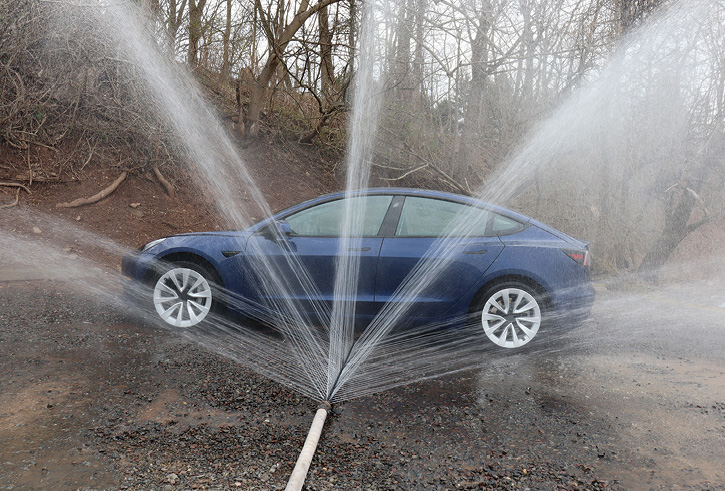
1 Ziamatic Corp. makes two models of its Vehicle Cooling Unit that are designed to provide a 140-degree spray pattern to cool the pan at the bottom of the battery compartment in an EV fire. (Photo 1 courtesy of Ziamatic Corp.)
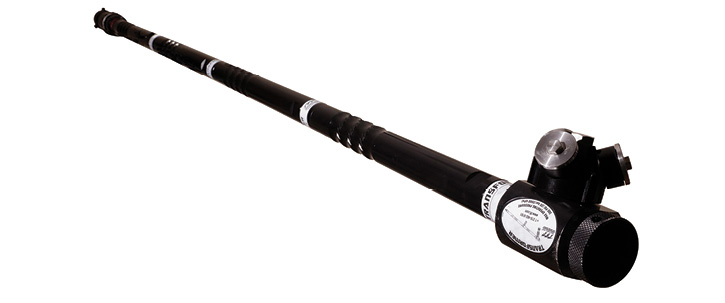
2 Task Force Tips makes the Transformer EV Nozzle system that can be slid under an EV to cool its battery pan during a fire. (Photo 2 courtesy of Task Force Tips.)
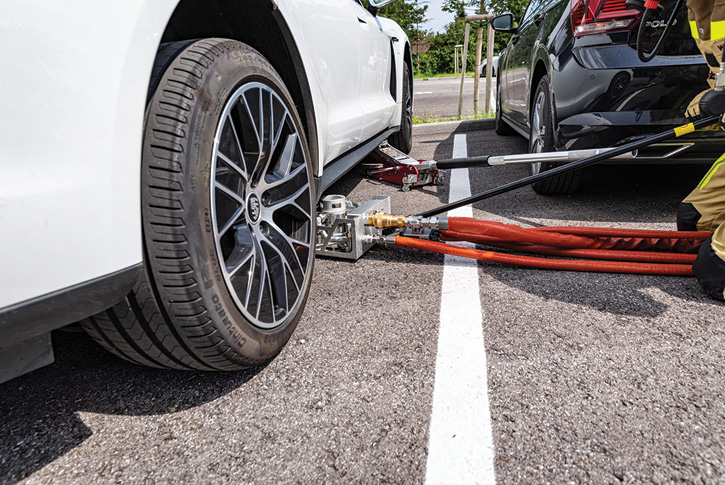
3 The Rosenbauer BEST system uses a piercing nozzle that directly injects water into EV battery modules to rapidly cool thermal runaway fires. (Photo 3 courtesy of Rosenbauer.)
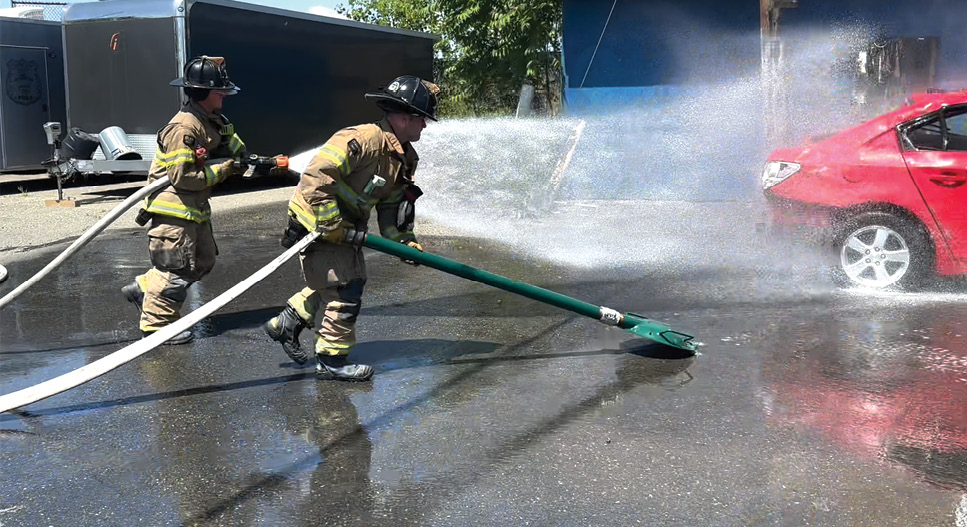
4 The Turtle Fire System will deliver more than 500 gpm at 100 psi supplied by two lengths of 2½-inch hose. (Photo 4 courtesy of Turtle Fire Systems.)

5 JKKS Systems makes the Rice Applicator, a device designed to be connected to a 2½-inch hoseline that can flow 600 gpm at 100 psi. (Photo 5 courtesy of JKKS Systems.)
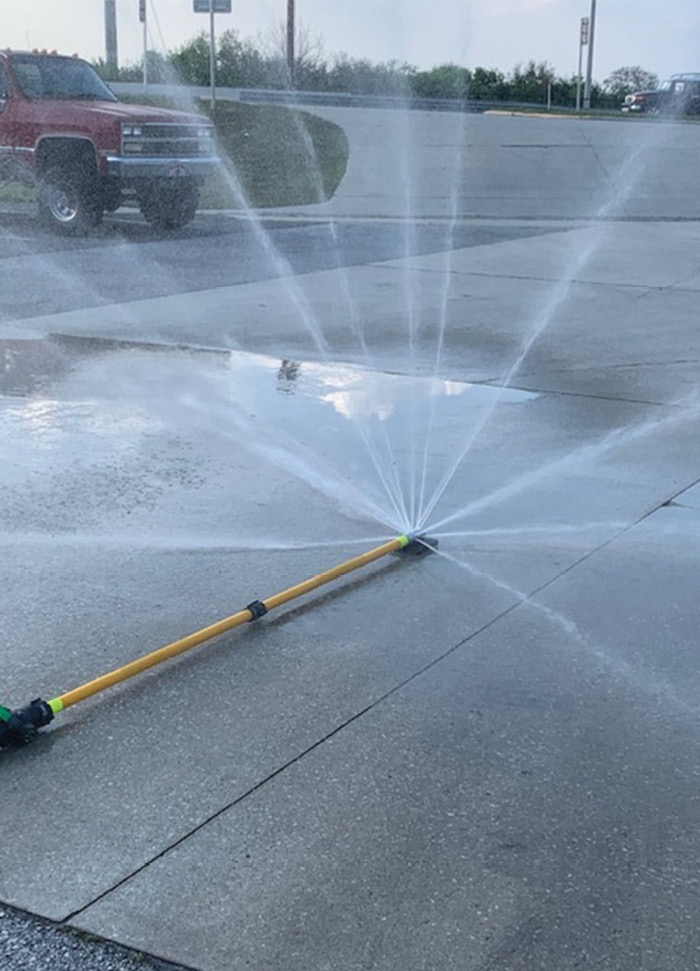
6 A-FAST makes the A-FAST-10 lithium-ion car battery cooling pipe assembly that cools an EV battery pack from beneath the vehicle. (Photo 6 courtesy of A-FAST.)
Hayes says the Turtle will deliver more than 500 gpm at 100 psi supplied by two lengths of 2½-inch hose. “When the unit is charged, there’s 800 pounds of force driving the unit back into the ground,” he says, “and our device can be gated down from 500 gpm if needed.”
John Tabor, Kevin Sheehan, and Steve Zisa are all longtime firefighters in the Paramus (NJ) Fire Department and partners in JKKS Systems, developer of the Rice Applicator for EV vehicle fires. “We all thought there’s got to be an easier way of dealing with an EV fire rather than picking it up and putting it in a dumpster or submerging it in water, so we brainstormed some ideas and came up with a prototype unit,” Tabor says. “We eventually went into production with our third prototype.”
Tabor says the Rice Applicator, named after the late Tim Rice, a Paramus fire captain, is 46½ inches long, weighs 35 pounds, and has an application area of 6 inches wide by 2 inches high with 120 holes drilled across the top at different angles to cover a significant area. “It’s designed to be connected to a 2½-inch line but can be adapted down to smaller diameters,” he notes. “We recommend starting out with a high flow of 600 gpm at 100 psi and gradually reducing down to about 25 psi. The device is designed for deployment by a single firefighter and comes with two 14-inch-wide handles on the side to allow the unit to be pushed into position by a pike pole.”
Dion LeMieux, owner of A-FAST, says his company makes the A-FAST-10 lithium-ion car battery cooling pipe assembly that cools an EV battery pack from beneath the vehicle. The assembly consists of a 72-inch-long base and a 36-inch extension pipe, making a unit of 9 feet in total. “The nozzle and tip pipe are attached to a baseplate/skid unit for stability,” LeMieux points out, “and the nozzle tip flows between 50 and 90 gpm, depending on the pressure used.”
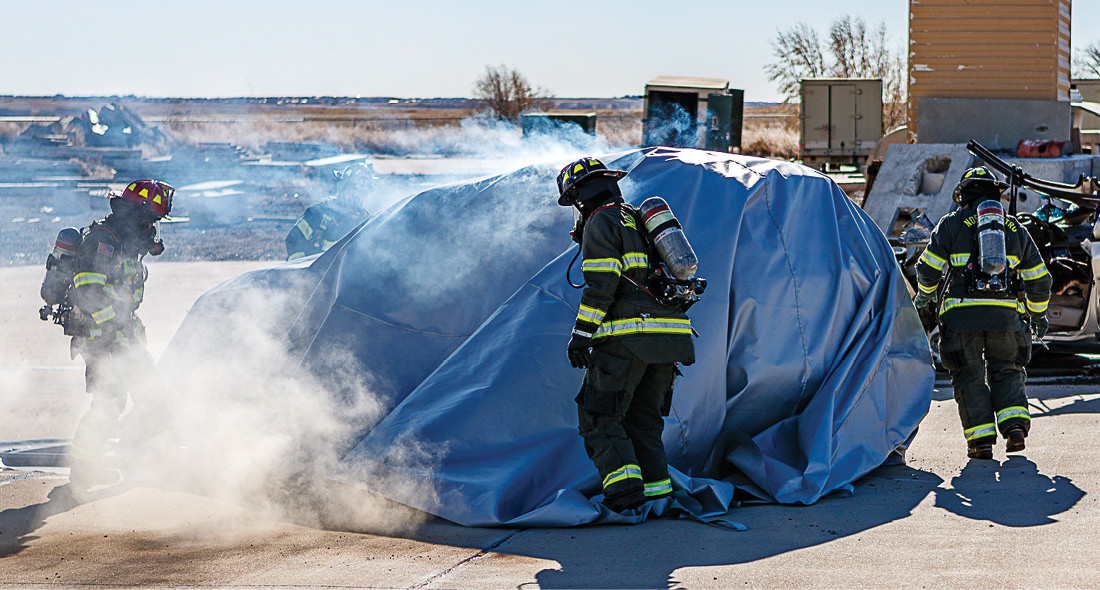
7 Darley offers the Fire Blanket, which is used to isolate an EV fire and control it to let it burn out at a slower rate. (Photo 7 courtesy of Darley.)

8 Garrison Flood Control Systems makes the MAYIM Modular Flood Barrier that can be used to create a flooded sealed perimeter to submerge a burning EV. (Photo 8 courtesy of Garrison Flood Control.)
Darley has two products for dealing with EV fires and emergencies, says Ryan Darley, vice president of sales. “We offer the Fire Blanket, which does not extinguish the fire but contains it to allow it to burn out under the blanket to protect exposures,” Darley notes. “The Fire Blanket knocks the fire temperature down quickly by depriving it of oxygen, but the battery will continue to burn due to thermal runaway. The Fire Blanket isolates the fire and controls it to let it continue at a slower rate, with no sparks emanating to start other fires.” The Fire Blanket comes in a variety of sizes, but the two standard sizes are 6 × 8 meters and 6 × 9 meters, which will cover SUVs. Darley adds that the blanket is about as thick as an outer layer of personal protective equipment (PPE) but with a silicone coating.
Darley also offers an EZ Plug, which is not meant for an EV fire but to prevent an EV from accidentally moving after a crash or other type of incident. “A firefighter puts the EZ Plug in the vehicle’s charging port, and it simulates that the vehicle is charging, which automatically puts the vehicle into neutral or park, depending on the vehicle model,” Darley points out. “EVs have so much torque and horsepower that they often jump over wheel chocks, so the EV Plug can keep firefighters safe when approaching a disabled EV.”
In the submerge category of dealing with an EV fire, Garrison Flood Control Systems makes the MAYIM™ Modular Flood Barrier, consisting of interlocking panels that create a sealed perimeter, which can be flooded with water or foam. A typical EV pool would use 40 to 50 straight sections and 12 corner pieces to create a four-sided pool around a vehicle fire, which can then be filled with 20 to 30 inches of water to submerge the lithium-ion battery and help extinguish the fire.
ALAN M. PETRILLO is a Tucson, Arizona-based journalist, the author of three novels and five nonfiction books, and a member of the Fire Apparatus & Emergency Equipment Editorial Advisory Board. He served 22 years with the Verdoy (NY) Fire Department, including in the position of chief.

